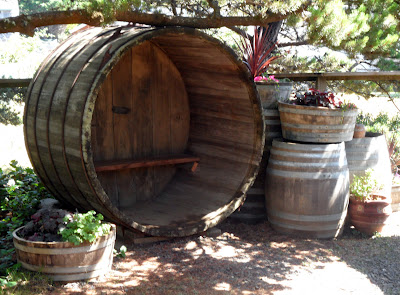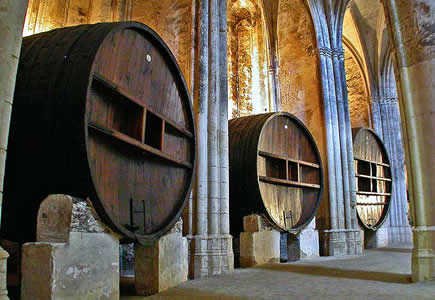
Have you ever seen one of those huge wine fermentation tanks?
I have to admit that before seeing one I myself didn’t even know they existed.
They look like the parents and grandparents of a regular size barrel, keeping most of the familiar features of the ‘little’ ones, although on an oversized scale. Standing next to one might give you the illusion of having shrunk as the result of a weird science experiment.
The job of these massive casks is to contain the juice, freshly squeezed from the crushed grapes, and to witness its matrimony to the yeast; that will activate its fermentation (that magical conversion of simple sugar into alcohol).
After that, the precious liquid gets transferred into a variety of more modest vessels, including smaller oak barrels.
The aged oak of a well-made fermentation vat is as exquisite as its smaller relative. The staves are hefty, thick and extra long, and reddened in the inside by the aromatic must, just as the barrel staves are tinted by the aging wine. One thing is missing though: the extreme arch.
Because of its larger size, the vat is made with much straighter wood staves that are kept together by equally gigantic metal hoops.
Less known, less seen, less recognized, but just as important in winemaking, its aged oak carries just as much potential for ‘transformation’ into new beauty than any barrel.
Rescuing these giants seems a tribute to the craftsmanship of the artisans behind their creation; they are an almost extinct species as the wooden containers are being replaced by more modern metal alternatives. Our Ponte Vecchio bench is a tribute to them.
The seat’s silhouette has been augmented by a silky wave that makes it deliciously smooth to the touch and sensual to the eye. The staves have been reunited with the metal band that once held them together; the hoop now supports the structure and adds architectural lines to the design.
In Florence, Italy, Ponte Vecchio, the oldest medieval bridge in the city, is famous for its beautiful arches. We see a fermentation tank as the ‘uncelebrated’ bridge between the unrefined must and that distinguished juice that will continue its journey to ultimately end up, well…. in your glass.
I have to admit that before seeing one I myself didn’t even know they existed.
They look like the parents and grandparents of a regular size barrel, keeping most of the familiar features of the ‘little’ ones, although on an oversized scale. Standing next to one might give you the illusion of having shrunk as the result of a weird science experiment.
The job of these massive casks is to contain the juice, freshly squeezed from the crushed grapes, and to witness its matrimony to the yeast; that will activate its fermentation (that magical conversion of simple sugar into alcohol).
After that, the precious liquid gets transferred into a variety of more modest vessels, including smaller oak barrels.
The aged oak of a well-made fermentation vat is as exquisite as its smaller relative. The staves are hefty, thick and extra long, and reddened in the inside by the aromatic must, just as the barrel staves are tinted by the aging wine. One thing is missing though: the extreme arch.
Because of its larger size, the vat is made with much straighter wood staves that are kept together by equally gigantic metal hoops.
Less known, less seen, less recognized, but just as important in winemaking, its aged oak carries just as much potential for ‘transformation’ into new beauty than any barrel.
Rescuing these giants seems a tribute to the craftsmanship of the artisans behind their creation; they are an almost extinct species as the wooden containers are being replaced by more modern metal alternatives. Our Ponte Vecchio bench is a tribute to them.
The seat’s silhouette has been augmented by a silky wave that makes it deliciously smooth to the touch and sensual to the eye. The staves have been reunited with the metal band that once held them together; the hoop now supports the structure and adds architectural lines to the design.
In Florence, Italy, Ponte Vecchio, the oldest medieval bridge in the city, is famous for its beautiful arches. We see a fermentation tank as the ‘uncelebrated’ bridge between the unrefined must and that distinguished juice that will continue its journey to ultimately end up, well…. in your glass.






 RSS Feed
RSS Feed